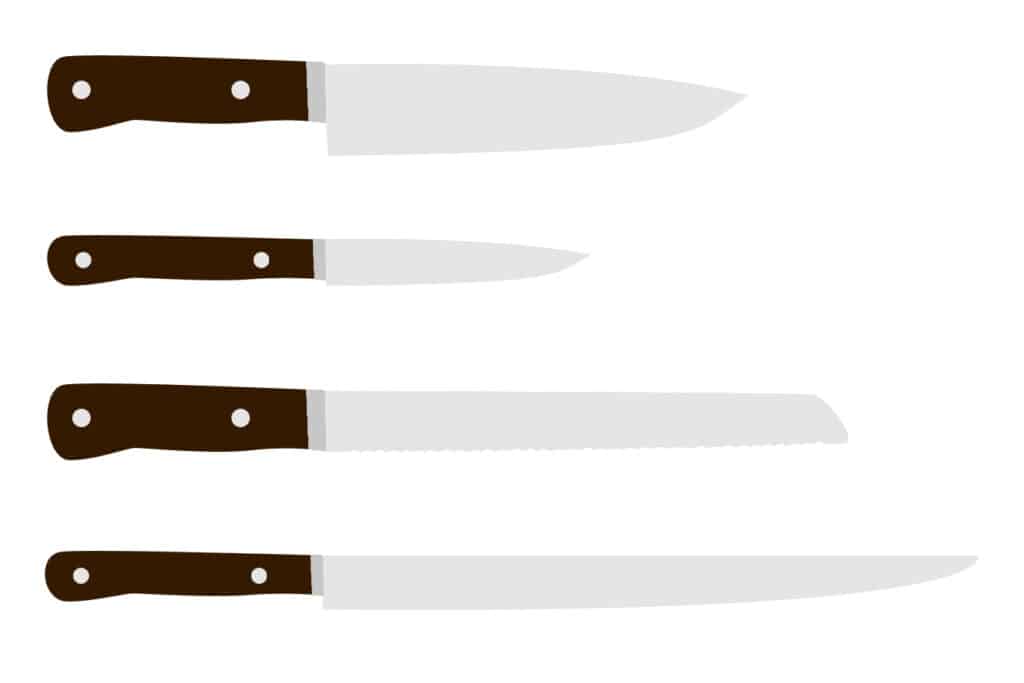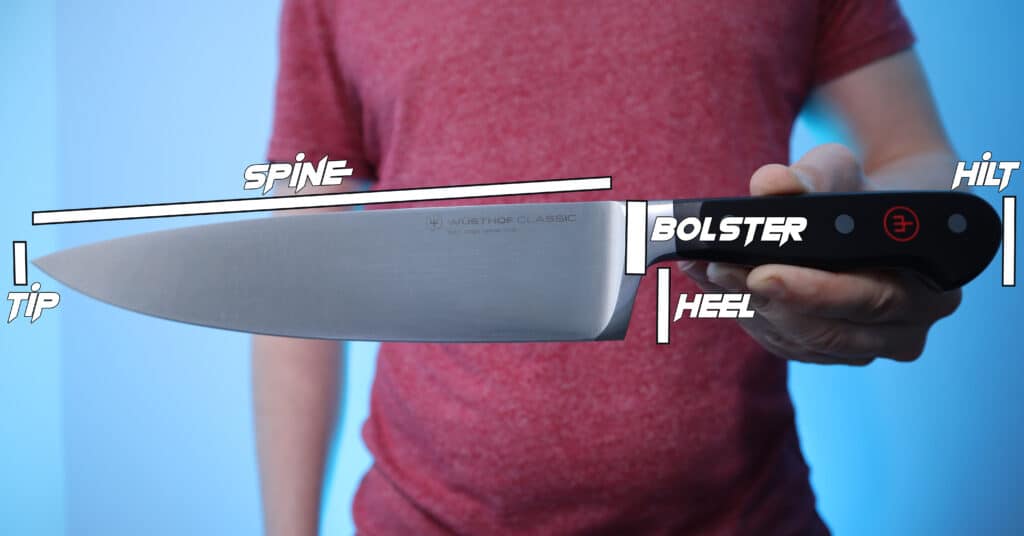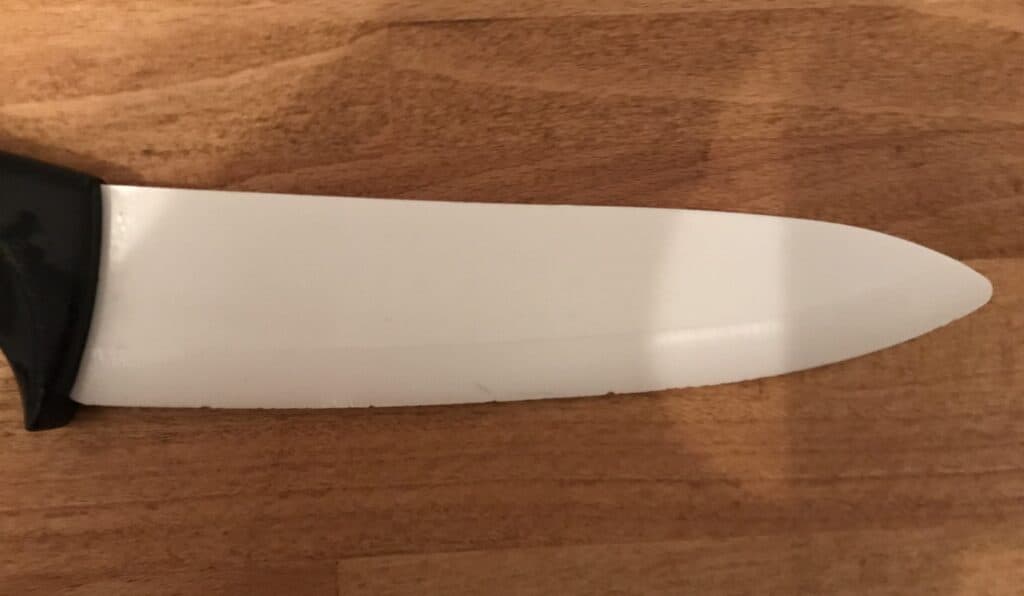
There is a huge range of kitchen knife types, from peeling an apple to butchering a chicken, there are tens of specific knives for specific jobs.
But as a home cook, do we really need to own a ‘salmon knife’, for all those times when we want to fillet and skin a salmon to perfection? I don’t think so (Unless you live in Alaska maybe).
I think the home cook can get away with just four knives, each has its own particular benefits and a wide range of uses. With these four knives, I think the home cook can pretty much achieve any job in the kitchen. The four kitchen knives everyone needs are:
- Chef’s Knife
- Paring Knife
- Serrated Knife
- Carving Knife
Read on to learn why I think everyone needs these four knives, how to use them and how much they should cost.
Chef’s Knife

What is a Chef’s knife
Out of the four knives in this article, your chef’s knife is, by far, the most important one. The chef’s knife is a multi-purpose knife and the look of it is probably the one you are most familiar with when you think of kitchen knives.
It has been designed specifically to be an all-rounded rather than adapted to a specific task in the kitchen. You could easily perform 80% of knife tasks using a chef’s knife.
A chef’s knife has a long blade, around 8 to 12 inches in length. A bolster connects the blade and the handle and protects your fingers from the knife. They have large heels to allow room for your knuckles when chopping. Chef’s knives come in all types of sizes so I spent some time writing an in-depth article about how big your chef’s knife should be which you should check out before buying one.
If you’re moving from home, or just want a whole new set of knives then you need to start with a chef’s knife.
Why you need a Chef’s knife
A chef’s knife is the most multipurpose knife in the kitchen. It can be used to cut poultry, beef, fruit, and vegetables. A good quality chef’s knife can even be used to break through smaller bones such as chicken bones without much risk of damaging the knife.
The long flat blade is also perfect for other kitchen tasks such as crushing garlic cloves, you can scoop freshly cut herbs onto the side of the blade to carry over to your cooking pan, it truly is a universal knife.
Its large size doesn’t restrict it’s precision either. A good quality chef’s knife can have a razor-sharp blade which makes it perfect for fine slicing.
How to use a Chef’s knife
First and foremost, a chef’s knife can be dangerous, it’s relatively heavy and very sharp. In fact, it is actually more safe to keep your chef’s knife sharp as it is harder to control a blunt chef’s knife and increases the likelihood of the blade diverging when cutting, possibly onto your fingers! I actually wrote a full article on how to hold food when cutting which is really useful for beginners.
So rule number 1, keep it sharp.
To hold a chef’s knife I like to use a technique called choking the blade. This is where you use your index finger and thumb to grip the heel end of the blade, with the rest of your hand holding the handle, this gives you better control over the knife when cutting.
How much you should spend on a Chef’s knife
Your chef’s knife is the most important knife in the kitchen and it’s also the one which will take by far the most wear.
Because of this, I think it’s important to choose a quality chef’s knife, one which will be comfortable and has a robust and durable blade with a sharp edge.
I really like the Zelite Infinity Chef’s Knife. It’s a good size and there is a good balance to the knife. The blade is super sharp and very durable. It’s high chromium content also makes it very resistant to rust so it’ll be easier to maintain.
For its quality, it’s a relatively inexpensive chef’s knife and I think it’s perfect for the home cook.
Paring Knife

What is a paring knife
A paring knife is the second most versatile knife in your kitchen. It’s smaller than a chef’s knife with a blade length of around 3 to 4 inches.
The blade is very smooth and sharp with a slightly curved edge from bolster to tip. Paring knives don’t have the same large heel as chef’s knives as they are not intended for long periods of chopping but rather smaller, more delicate tasks.
Why you need a paring knife
A paring knife is typically used for smaller jobs than a chef’s knife. For example, you might choose to use a paring knife for trimming excess fat off a piece of meat, and they are quite popular for preparing smaller fruit and vegetables, such as slicing cherry tomatoes and strawberries or peeling and slicing potatoes or apples.
They are easy to handle and lightweight so although they still have a sharp blade, they can be safer for smaller tasks as it’s more difficult to cause serious damage with a paring knife.
How to use a paring knife
Paring knives are quite small so easily fit into the hand making them easy to control. For slicing, I prefer to choke the blade in a similar way to a chef’s knife, using my index finger and thumb to grip the blade, giving you more control.
When using the blade to peel, I like to hold the handle in a way that the blade edge faces my chest. Holding the food in my other hand I carve around the outside of the food to peel off the outer layer. It’s easier if you see this method in real life so here’s a quick and helpful video showing you how to peel with a paring knife.
How much you should spend on a paring knife
Paring knives are important for your kitchen but due to their size, they are pretty inexpensive.
You can pick up a quality paring knife for not too much money. Personally I like this ProCook Professional X50 Paring Knife. It’s sharp, has a nice comfortable design and should last you a very long time.
Serrated Knife / Bread Knife

What is a serrated knife
A serrated knife often called a bread knife, is a long knife with a serrated blade. Usually, around 10 inches in length although the size and shape of serrated knives can alter quite significantly.
This is much more of a specific knife than both the chef’s knife and a paring knife. However, it does its job so well that it really is worth having in the kitchen.
The serrated blade also helps to keep the knife sharp for a very long time, as the teeth of the blade help protect the sharp inside grooves from the impact on cutting boards and such which chef’s knives have to endure.
Why you need a serrated knife
Serrated knives are great at slicing through difficult food with varying densities. This is what makes them perfect for bread knives, which have a harder outside layer and a softer inner, a serrated knife can easily tear through the harder crust and then slice the softer inner section.
Although they are often known as bread knives, this advantage helps with all sorts of food such as citrus fruits which have very tough outer skin. Serrated knives are also great at cutting through ticky pieces of meat which may have soft flesh and tough fat and gristle, a serrated knife will cut through this type of meat with ease whereas a chef’s knife might struggle.
An example we can all relate to is the steak knife, the serrated blade makes it perfect for slicing through both tender meat, but also the tougher fatty parts of the steak. It’s just the same idea for these larger serrated knives.
How to use a serrated knife
Serrated knives are a little less dangerous than chef knives and paring knives. This is because you cut more slowly using a serrated knife.
When using a serrated knife, firmly hold the handle with your lead hand, holding the food item in place with your other hand (or a fork).
Using a sawing motion cut through the food. A sharp serrated knife should slice through the food easily, using long strokes.
How much you should spend on a serrated knife
Serrated knives are great because a good quality one will take a long time to go blunt, so they need less maintenance than other knives.
I recommend this PAUDIN Serrated Knife. It’s a good size, suitable for a range of tasks. It’s good quality without being too expensive and has a comfortable handle.
Carving Knife

What is a carving knife
The carving knife may not be the first ‘essential’ knife which springs to mind but they are extremely useful members of your kitchen.
A carving knife is a long thin knife, around 8 – 15 inches in length. The blade is thinner than a chef’s knife, and the blade edge is generally flatter than the curved edge of a chef’s knife.
Like the serrated knife, the carving knife is designed for more specialist jobs than the chef and paring knives. However, for anyone who enjoys home cooking you will still find that you have lots of uses for a carving knife in day-to-day meal preparation, as well as special events.
Why you need a carving knife
Carving knives are used to cut thin slices of meat and poultry. They are thinner than a chef’s knife, allowing you to slice particularly thin cuts of meat.
A carving knife is perfect for cutting up a ham or turkey at thanksgiving. The blade is long so that you can slice straight through the meat in as few strokes as possible, allowing the knife to glide through the meat rather than saw through like a serrated knife would.
You may think that a carving knife would only be used for special occasions, but when you think that a carving knife is perfect for any time you make a roast chicken, or buy a nice big leg of ham, you’ll realize that a carving knife can be a very useful knife to own, at cutting thin, uniform slices can hugely enhance the flavor of your food.
How to use a carving knife
Firmly hold the handle of the carving knife in your lead hand, fixing the food in place with a fork in your left. You can use a normal fork for this job, but for larger cuts of meat, it can be easier with a specific carving fork, which has much longer prongs to help hold the meat.
Start with the tip end of the blade resting against the meat and slide the blade down and towards you. If the blade is nice and sharp you shouldn’t have to apply too much pressure.
Continue with these long sawing strokes until you have cut off a slice. You should be able to cut off a slice of chicken breast with just one or two strokes
How much you should spend on a carving knife
I think the Richardson Sheffield V Sabatier is a great carving knife for general home use. It is a good length and has a sharp straight blade. It also comes with a carving fork for a pretty good price.
Other Knife Related Essentials
I listed the four kitchen knives, everyone, needs but there are some other knife-related essentials that every kitchen needs.
Cutting Board
Why you need a cutting board
If you don’t want to completely ruin your kitchen worktops or serving plates then when you use a knife you’re going to have to do it on a cutting board.
Cutting boards can be made from pretty much any material but the most common are wood and plastic. They are a flat surface on which you cut food.
How much you should spend on a cutting board
A good cutting board can last you a lifetime, and they can be a very attractive part of your kitchen. This is going to be one of the most used items in your kitchen so it’s worth getting a good one. I love this Sonder LA, large teak end grain cutting board.
It’s made of end-grain teak wood which makes it super durable, with a drain channel around the edge to prevent spillage onto your kitchen worktop.and has rubber feet to prevent movement, it’s a really beautiful and practical cutting board.
Honing Steel
Why you need a honing steel
Honing steels are vital for knife maintenance. Not to be confused with sharpening rods (below), honing steels don’t actually sharpen your knives in the technical sense but they do help to realign the blade to make it more effective, and last longer.
I recommend sharpening a chef’s knife after at least every three cooking sessions, they are pretty inexpensive and are a vital part of your kitchen if you want to maintain your knife set.
How much you should spend on a honing steel
The SHAN ZU Honing Steel is a beautiful honing steel and should last for decades. It’s relatively inexpensive, especially for the quality. You can take a look on Amazon here.
Sharpening Rod
Why you need a sharpening rod
Unlike a honing steel, a sharpening steel does indeed sharpen blades. It does this by removing a thin layer of the blade, unveiling a new sharp layer underneath. Therefore, sharpening rods need to be made of a harder material than steel so that they can remove the steel from the blade. You’ll find ceramic and diamond-encrusted sharpening rods.
If you see a steel sharpening rod that this is actually properly a honing steel.
How much you should spend on a sharpening rod
The Wusthof ceramic sharpening steel is a great choice, high quality with a fine rod. You can check it out on Amazon here.
I prefer ceramic to diamond as the diamond sharpeners can often be too effective at stripping away the blade, taking off more steel than actually necessary.

